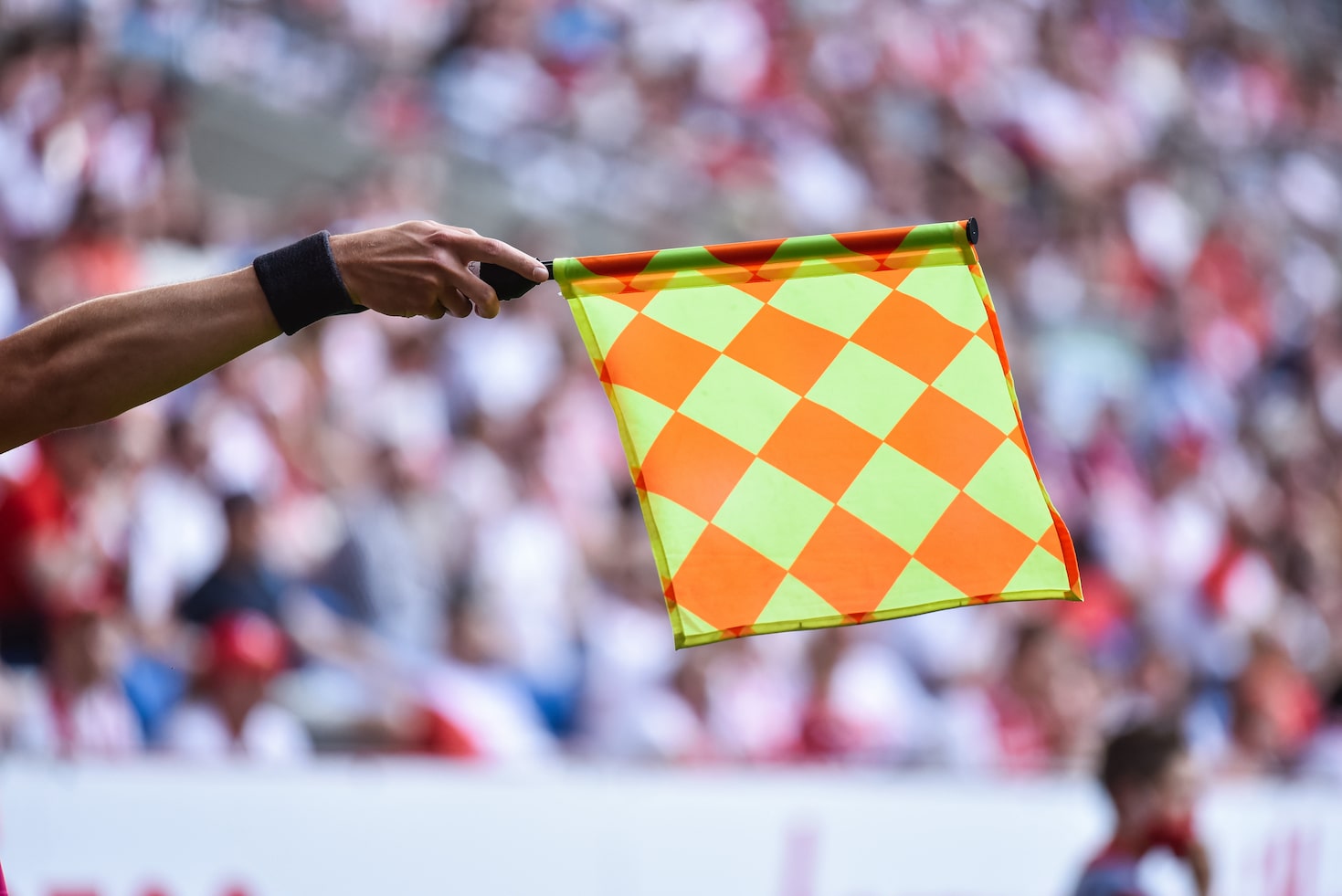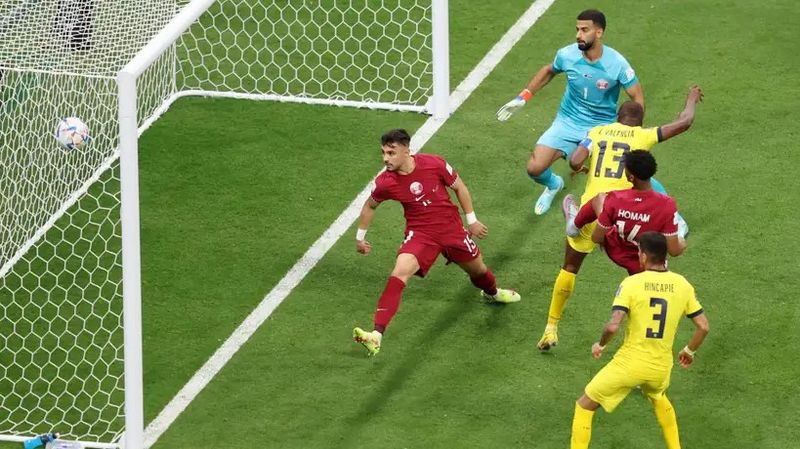Offside in soccer is a rule that penalizes players who are closer to the opponent’s goal line than both the ball and the second-to-last defender when the ball is played to them. A player is considered offside if they gain an unfair advantage by being in an offside position when the ball is passed to them.
The offside rule ensures fair play and prevents players from cherry-picking near the opponent’s goal. This rule encourages teamwork and strategic positioning, forcing players to time their runs accurately and stay level with or behind defenders. Understanding the offside rule is essential for players and fans alike, as it affects the flow and outcome of the game.

Credit: www.facebook.com
The Basics Of Offside
Understanding the concept of offside in soccer is crucial for players, coaches, and fans alike. Offside is a fundamental rule that regulates the movement of players during a game, ensuring fair play and preventing teams from gaining an unfair advantage. In this section, we will delve into the definition of offside and explore its purpose in the context of soccer.
Definition Of Offside
The definition of offside in soccer is when an attacking player is in an offside position at the moment the ball is played to them by a teammate. It is important to note that being in an offside position alone is not a violation. Rather, the player must also be involved in active play by either gaining an advantage from being in that position or interfering with an opponent.
Here’s how it works: A player is deemed to be in an offside position if they are closer to the opposing team’s goal line than both the ball and the second-to-last defender when the ball is passed to them. The second-to-last defender usually refers to the second-to-last outfield player, excluding the goalkeeper.
Purpose Of Offside In Soccer
The purpose of the offside rule is to promote fair play and maintain the balance between attacking and defending teams. This rule discourages players from cherry-picking, where an attacking player positions themselves close to the opposing goal line in hopes of receiving a long pass to score an easy goal.
By requiring players to be level with or behind the second-to-last defender at the moment the ball is played, offside helps keep the game dynamic and prevents constant long ball tactics. It encourages players to navigate the field tactically, create strategies, and build attacks through teamwork rather than relying solely on individual speed or positioning.
Furthermore, the offside rule helps maintain defensive integrity by preventing attacking players from gaining an unfair advantage over the opposing team’s defenders. It allows defenders to set up a defensive line, properly position themselves, and control the movement of attacking players.
In summary, offside is an essential aspect of soccer that ensures fairness and strategic play. It restricts players from simply waiting near the goal, emphasizes teamwork, and maintains a balance between attack and defense. Understanding the basics of offside is vital for both players and spectators to fully comprehend the dynamics of the game.
Determining Offside
Offside is a crucial rule in soccer that can often be contentious and lead to intense debates among players, coaches, and fans. It is important to understand how offside is determined in order to fully grasp its impact on the game. Determining offside involves assessing three key factors: the position of the attacker, the position of the defender, and the attacker’s involvement in active play.
Position Of The Attacker
The position of the attacker is a critical aspect when determining offside. According to the rules, an attacking player is considered offside if they are in an offside position at the exact moment the ball is played to them by a teammate.
So, what is an offside position? An attacker is in an offside position if they are nearer to the opponents’ goal line than both the ball and the second-to-last defender when the ball is played to them.
This means that if the attacker is level with the ball or level with the second-to-last defender, they are not in an offside position. However, if any part of the attacker’s body that can legally play the ball is ahead of the ball or the second-to-last defender, they are considered offside.
Position Of The Defender
The position of the defender is equally important in determining offside. The second-to-last defender is usually the last outfield player before the goalkeeper. It could be a defender or even a midfielder, depending on the defensive formation.
The distance between the attacker and the second-to-last defender is crucial in determining whether an offside offense has occurred. If the attacker is level with the second-to-last defender or behind them when the ball is played to them, they are not offside.
However, if the attacker is found ahead of the second-to-last defender when the ball is played, they are deemed to be in an offside position and can be penalized accordingly.
Involvement In Active Play
The attacker’s involvement in active play is another essential factor in determining offside. The rules state that an attacker who is in an offside position must also be involved in active play to be penalized.
An attacker is considered involved in active play when they either gain an advantage from their offside position or interfere with an opponent’s ability to play the ball. This can include actions such as interfering with an opponent, gaining an advantage from being in an offside position, or receiving the ball directly from a rebound or deflection off an opponent.
On the other hand, if the attacker is not actively involved in the play and does not affect the opponent’s ability to play the ball, they may be deemed as inactive and not penalized for being in an offside position.
Implications Of Offside
When it comes to soccer, understanding the implications of offside is crucial for players, coaches, and fans. The offside rule plays a significant role in the flow and outcome of a game, often leading to contentious moments and discussions. From offside infraction to controversial offside calls, let’s take a closer look at the various aspects that make offside a pivotal element in soccer.
Offside Infraction
An offside infraction occurs when an attacking player receives the ball from a teammate while positioned closer to the opponent’s goal line than both the ball and the second-to-last defender, commonly known as the last defender. This rule aims to prevent players from gaining an unfair advantage by staying in an offside position and receiving the ball closer to the goal than the defenders. Offside infractions often lead to heated debates among players and fans, especially when a goal-scoring opportunity is nullified due to an offside call.
Offside Decision And Free Kick
When the referee determines an offside infraction, the opposing team is awarded a free kick from the spot where the offside offender received the ball, presenting a chance for the defending team to regain possession and reset the play. This decision can significantly impact the momentum of the game, creating a strategic advantage for the defending team while leaving the attacking team frustrated by the missed opportunity. The offside decision and subsequent free kick serve as crucial turning points in soccer matches, influencing their outcome.
Var And Offside
The introduction of Video Assistant Referee (VAR) technology has brought about a new dimension to the interpretation of offside in soccer. VAR offers the opportunity for referees to review close offside decisions by using video replays, ensuring a more accurate and fair assessment of offside infractions. However, the use of VAR has also sparked controversy and drawn criticism from fans and pundits, as the precise nature of offside calls and the interpretation of marginal offside decisions continue to be contentious topics within the soccer community.
Controversial Offside Calls
Controversial offside calls often lead to intense discussions and debate within the soccer world, with fans, players, and managers scrutinizing the decisions made by referees and VAR officials. Whether it’s a disallowed goal due to a marginal offside or a contentious offside call that alters the course of a game, the impact of such decisions can be profound, influencing the outcome of matches and shaping the narrative of soccer competitions.
Exceptions To The Offside Rule
Exceptions to the Offside Rule in soccer provide interesting nuances that influence game dynamics. Understanding these exceptions is crucial for both players and fans to grasp the complexities of the sport.
Involvement Through A Throw-in
When a player is in their own half of the field or level with the second-to-last defender at the moment the ball is played, they are not considered offside from a throw-in. This exception allows for strategic positioning during a throw-in and creates opportunities for swift attacks.
Involvement After A Save Or Deflection
If a player is in an offside position at the moment when the teammate plays the ball to them but then the ball deflects off an opponent or the goalkeeper makes a save, the offside offense is nullified. This exception prevents unfair disadvantages caused by unintentional deflections and rewards quick reactions from attacking players.
Involvement From A Goal Kick Or Corner Kick
A player cannot be offside directly from a goal kick, corner kick, or throw-in. This exception allows for uninterrupted possession of the ball without facing offside restrictions, promoting fluid play and strategic set pieces.
Interpretation Challenges
Offside in soccer presents interpretation challenges for both players and officials. Understanding the offside rule requires knowledge of position and timing, making it a complex aspect of the game.
Interpretation Challenges Offside is a crucial concept in soccer, but its interpretation can pose significant challenges for both players and referees. Close Calls and Marginal Offsides, Advancements in VAR Technology, and Consistency in Offside Decisions are key areas where these challenges often arise.
Close Calls And Marginal Offsides
In the fast-paced world of soccer, close calls and marginal offsides can make or break a team’s chances of scoring. These are the situations where a player is positioned just slightly beyond the last defender when the ball is played. The decision of whether it is an offside or a legitimate play can be a difficult task for referees. These close calls require careful analysis of the player’s position and the precise moment the ball is played. referees must make split-second decisions that can have a significant impact on the outcome of the game.
Advancements In Var Technology
With the introduction of Video Assistant Referee (VAR) technology, the interpretation of offside has become more accurate and consistent. VAR allows referees to review and analyze close calls and marginal offsides using video footage from multiple angles. This technology has aided in reducing human error and has helped referees make more informed decisions. However, despite the advancements, VAR technology is not foolproof, and there have been instances where controversies still arise.
Consistency In Offside Decisions
One of the main challenges in interpreting offside is maintaining consistency in decision-making. Different referees may interpret offside situations in slightly different ways, leading to confusion and controversy. This lack of uniformity can frustrate players, coaches, and fans alike, as the same situation may be deemed offside in one game and not in another. It is essential for officials and governing bodies to work towards establishing clear guidelines and ensuring consistent application of the offside rule across matches. In conclusion, the interpretation challenges in offside decisions can lead to significant debates and controversies in soccer. Close calls and marginal offsides, advancements in VAR technology, and the need for consistency are all crucial aspects that contribute to the complexity of this rule. As the game continues to evolve, finding the right balance between human judgment and technological assistance will be key in providing fair and accurate offside decisions.

Credit: www.cupello.com

Credit: betimate.com
Frequently Asked Questions
What Does An Offside Mean In Soccer?
Offside in soccer occurs when an attacking player is ahead of the second-to-last defender when the ball is played to them. It results in a free kick for the opposing team from where the offside offense happened.
How Do You Explain Offsides In Soccer To A Child?
Offsides in soccer happens when a player is closer to the opponent’s goal than the ball and the second-to-last defender. This prevents unfair advantage by stopping players from cherry-picking near the goal.
How Do You Know If You Are An Offside In Football?
In football, you’re offside if you’re closer to the opponent’s goal line than the ball and the second-last defender.
How Do You Not Be Offsides In Soccer?
To avoid being offsides in soccer, stay even with the second-to-last defender when the ball is played. Watch the defender’s position and time your run carefully to stay onside during play.
Conclusion
To summarize, understanding the concept of offside in soccer is crucial for players, coaches, and fans alike. It is a complex rule that requires careful analysis and adherence to the rules of the game. By avoiding offside situations, teams can maximize their scoring opportunities and enhance the overall flow of the game.
So, next time you’re on the pitch or watching a match, keep a keen eye on the offside rule and appreciate its role in the beautiful game of soccer.








